
|

|
Trumeau from the frontThis marble trumeau is 3.52 meters high and about .72 meters wide. The same rosettes that march across the lintel continue down the trumeau. Like the jambs, the outer edge of the trumeau is cusped, a form that derived from Islamic architecture. |
| |
|
Three crossed pairs of stylized lions (left: bottom; center; middle of trumeau; right: top)The lions, male and female (obvious by the teats of the females), are superimposed with the lioness always in front; they face in alternating directions from pair to pair. The intertwined tails, which swing back to the central empty space, differ as well with elaborate and unnatural terminations. |

|
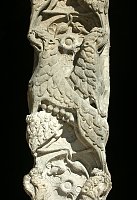
|
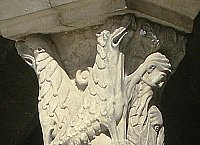
|
| |
|
Right side of trumeau: Jeremiah?Like Paul below, Jeremiah backs into a column, which terminates in a foliate capital. This sculpture is one of the best known at Moissac, perhaps because this elongated figure, with graceful crossed legs, and with a faraway intense expression embodies the idea of mystic visionary or prophetic inspiration. The drapery folds imitate the linear qualities of manuscript illumination. In the final analysis, it seems odd to have figures of this importance on the less visible narrow sides of the trumeau. |

|
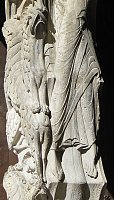
|
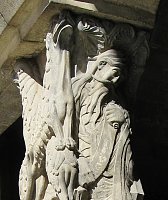
|
| |
|

|
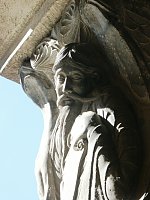
|
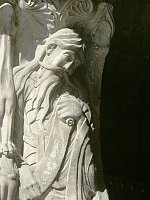
|
| |
|
Left side of trumeau: St. Paul?Like Jeremiah above, this figure is compressed within a narrow frame; Paul's bent knees, though elongated, seem less expressive than Jeremiah's twisted pose. Traditionally Paul is shown as bald, and appropriately with a severe expression--here with a wrinkled brow. Paul, here, faces the other great founder of the church, St. Peter on the jamb. They represent the New Law as opposed to Jeremiah and Isaiah on the opposite side of the trumeau and portal. |
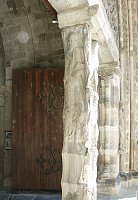
|
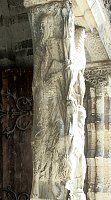
|
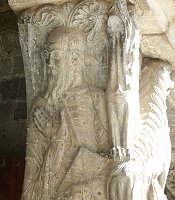
|
| |
|
Trumeau from insideThe back side of the trumeau has repeated engraved semicircular scales. |

|

|
| |
|
Left and center: Left jamb: St. Peter; right: right jamb: IsaiahAlthough these figures are the same size, they are not the same distance from the ground or from the edge of the jamb. They almost seem to be applied to the wall since they don't actually relate to the architecture--except to the curvilinear forms of the cusps. Peter, like the seraph and Matthew above, is an expressive, elongated figure, with distorted anatomy, limbs in opposing directions, imbalanced and exhibiting torsion. His left wrist is bent unnaturally and posed with the right hand to display his signature keys. He stands on a lion. Isaiah, on the other jamb, holds the scroll of his prophesy--the Virgin birth, which is illustrated in sculpture on the nearby east wall with stories relating to the birth and infancy of Christ. He seems less animated and is certainly more eroded with fewer telling details. |
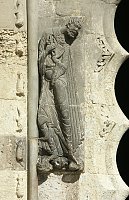
|

|

|
| |
|
|
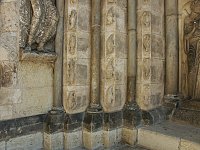
|

|


 Go to Moissac Index.
Go to Moissac Index. Click here to return to index of art historical sites.
Click here to return to index of art historical sites.
 Click here to return to index of artists and architects.
Click here to return to index of artists and architects.
 Click here to return to chronological index.
Click here to return to chronological index.
 Click here to see the home page of Bluffton University.
Click here to see the home page of Bluffton University.

